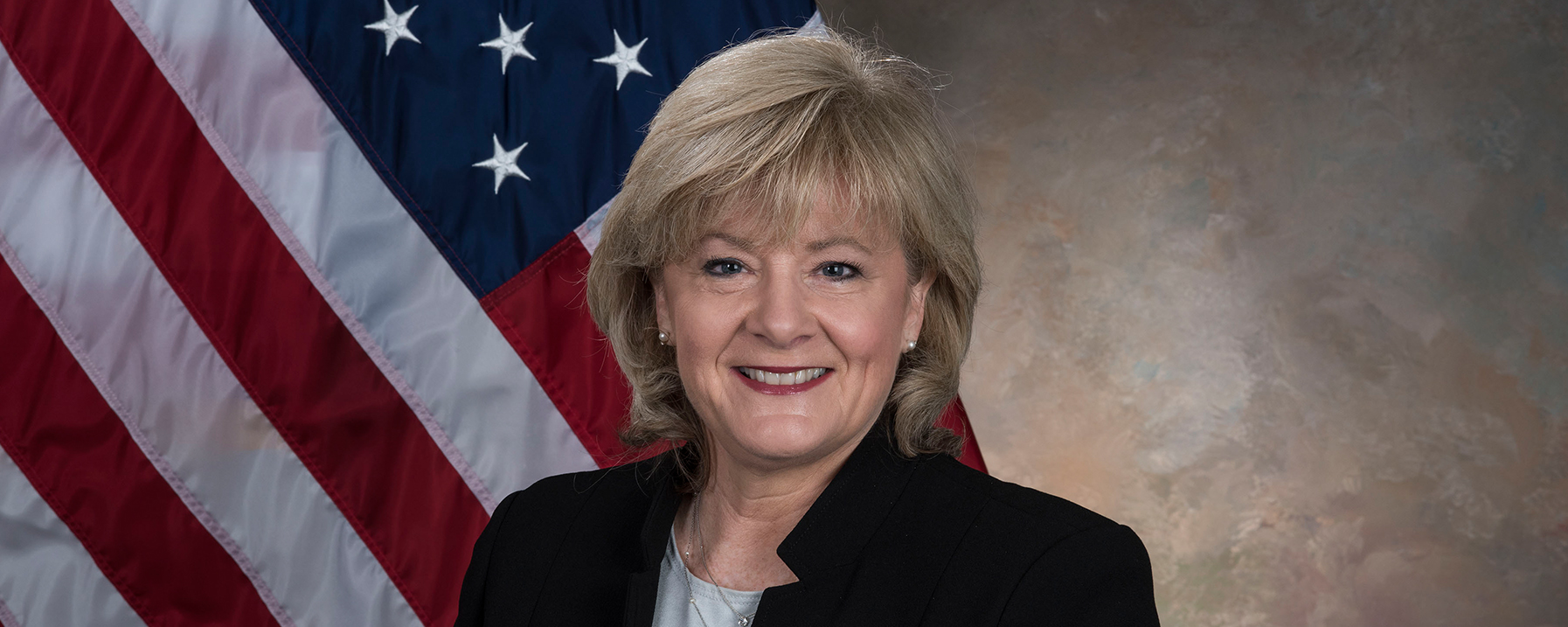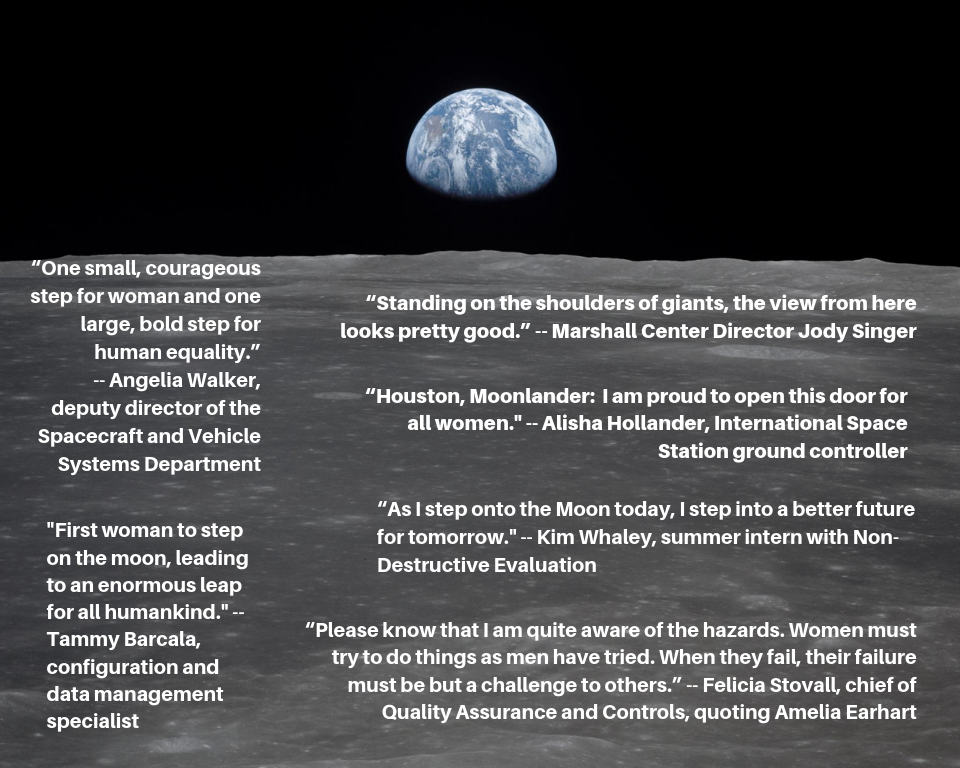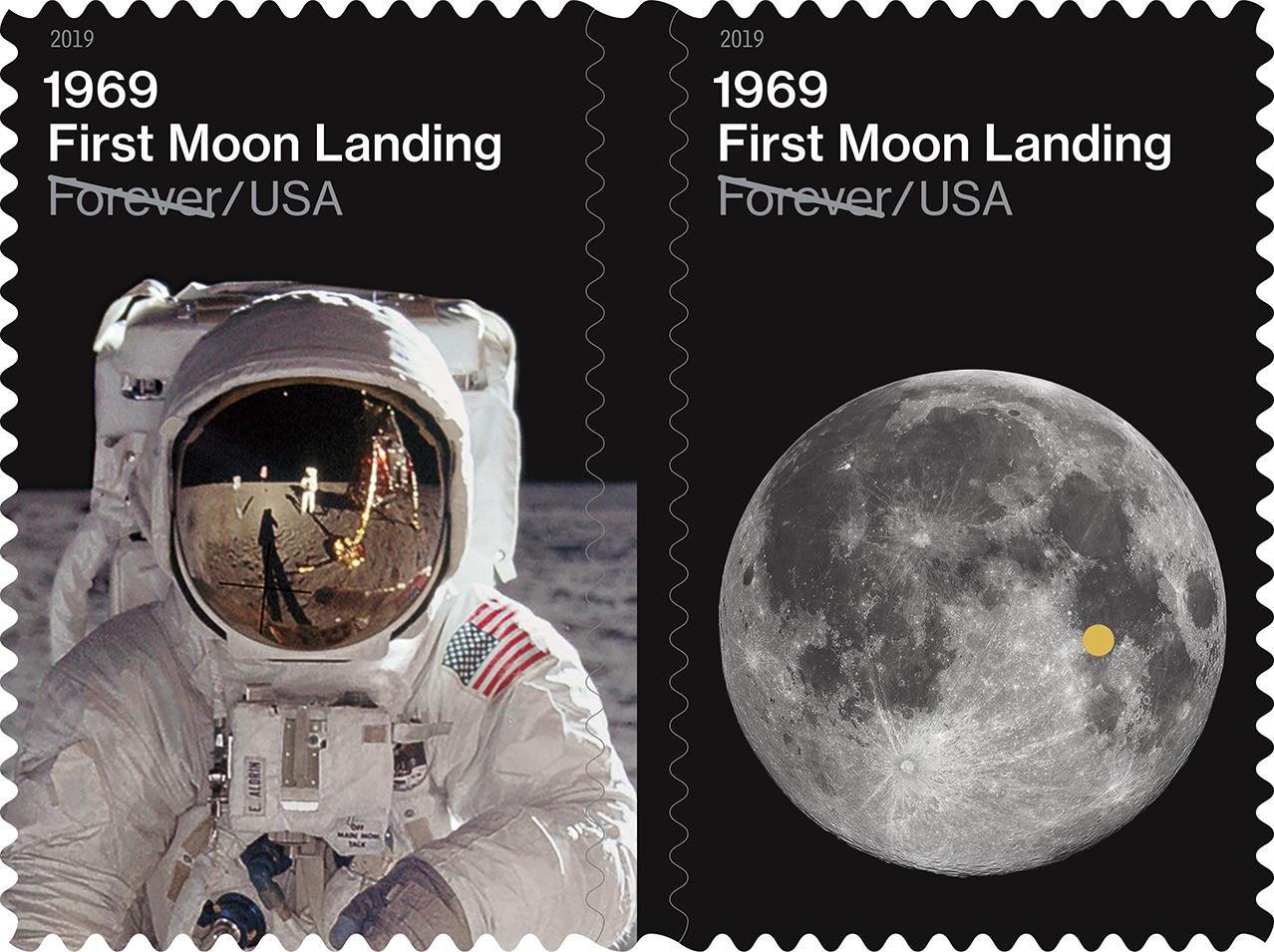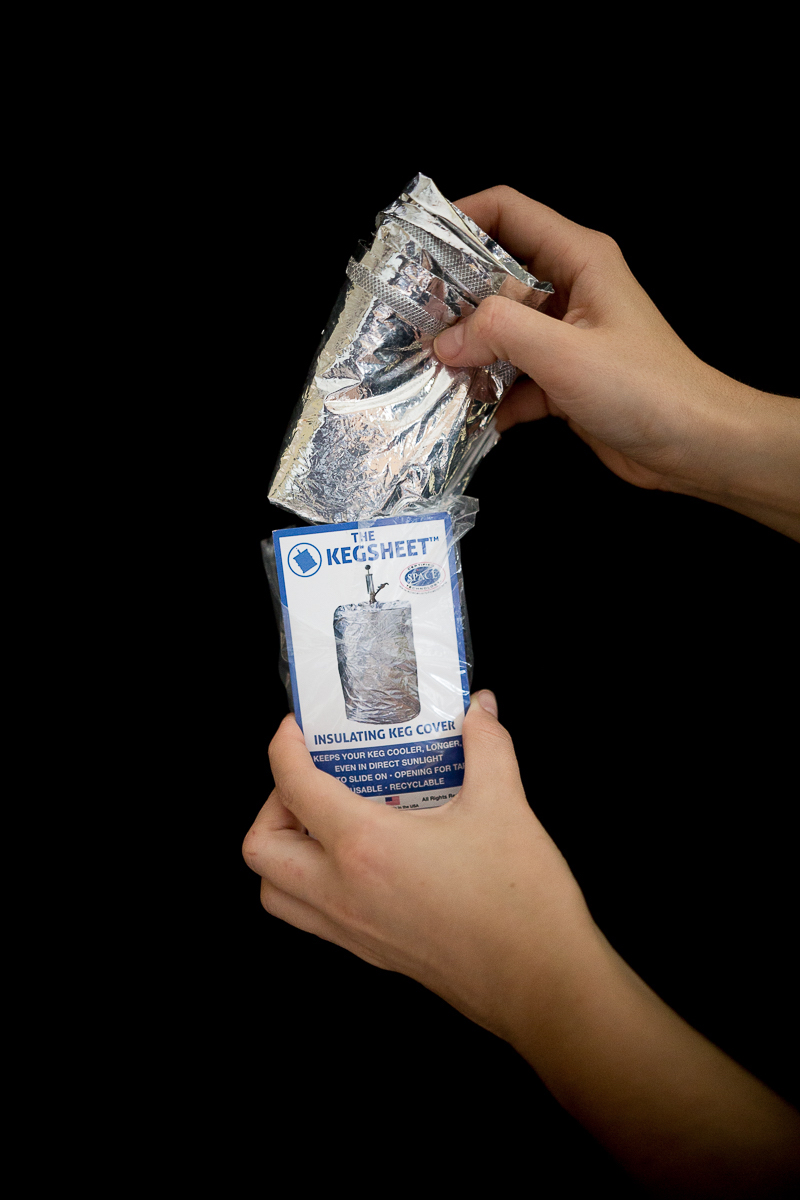In This Week’s Star
- Director’s Corner: Remembering Apollo and Looking to the Future
- Thousands of Model Rockets Take to the Sky to Set World Record
- Science at the Moon: Still Much to Learn, say Marshall Researchers
- What Would the First Woman on the Moon Say?
- Solving Combustion Instability Saved America’s First Trips to the Moon
- Shooting the Moon: Local Photographer’s Image Selected for Apollo Postage Stamp Collection
- Space Blanket, Dampers Among Apollo Program’s Legacy of Spinoffs
- Rocket Science in 60 Seconds: How Many Centers Work on the NASA Artemis Program?
- NASA SLS Rocket Testing Ensures Astronaut Safety, Mission Success
- Marshall Remembers Apollo
- Marshall Retirees Association Plans Memorial to Honor Space Explorers
- Car Show Brings Memories, Nostalgia of Early Rocketry Days
- This Week in NASA History: Apollo 11 Launches – July 16, 1969
Director’s Corner: Remembering Apollo and Looking to the Future
Fifty years ago, Apollo 11 captured the world’s attention and demonstrated the power of America’s vision and technology to inspire generations of great achievements, exploration and scientific discovery. I recall playing outside on a hot summer day and being called inside my grandmother’s house to watch the Moon landing. I was amazed at not only what I was seeing, but what the world was seeing. As we try to channel the wonder of that event that brought America together, we do so standing on the shoulders of giants who paved the way for this new era of human deep space exploration.
Today, the Artemis program is returning humanity to the Moon and through the development of new rockets, spacecraft, technology and groundbreaking science, we will boldly take the next giant leap — sending astronauts to Mars. Greek mythology identifies Artemis as the twin sister of Apollo and goddess of the Moon. Our return to the Moon represents our nation’s innate drive to explore, and pursue exciting and bold challenges that promise to expand our understanding of our nearest heavenly neighbor and set our course to Mars.
The architecture for Artemis is already taking shape right here at Marshall. For more than five decades, YOU, the Marshall workforce have, and continue to help enable extraordinary American missions of science, discovery and exploration. NASA continues to rely on our legacy and expertise in rocketry and space systems to mature technologies needed for deep space exploration.
The achievements of Apollo and everything since would not have been possible without you!
Today, we are focused on landing the first woman, and next man, on the Moon by 2024, followed by sustainable missions by 2028. This effort with our industry and international partners will create the sustainable architecture for all future space exploration. Just as Apollo inspired a generation, NASA will continue to inspire with feats of science and exploration today that will create a new generation of American Moon walkers and pioneers. The inspiration we’ll provide to the next generation helps us successfully draw new talent to the science, technology, engineering and math careers of tomorrow. With our goal of sending humans to Mars, Artemis is the first step to begin this new era of exploration.
While we reflect on the past and the significance of one of humanity’s greatest achievements 50 years ago, we want to keep a sharp eye on the future and how the next generation will view our accomplishments in the annals of history. The celebration of the Apollo 11 Moon landing allows us, as a community and a nation, to reignite our passion for deep space exploration.
The Apollo missions went to the Moon because we were destined to explore and see it with our own eyes. We turn toward the Moon now not as a conclusion, but as preparation and a checkpoint for all that lies beyond.
Thousands of Model Rockets Take to the Sky to Set World Record
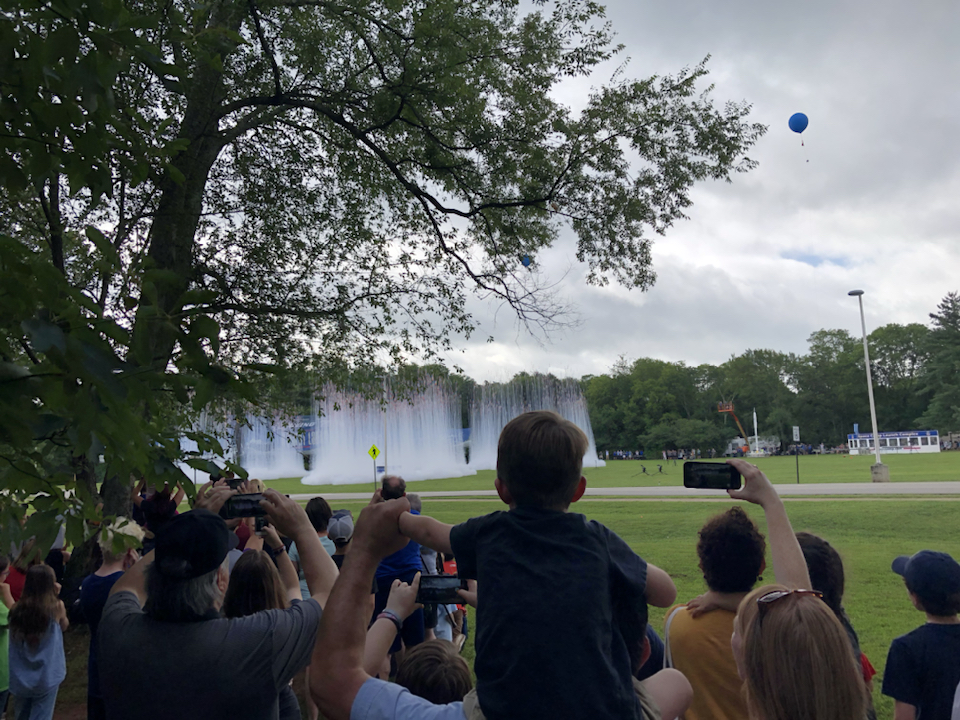
Five thousand model rockets take to the sky at the U.S. Space & Rocket Center on July 16 in an attempt to set a Guinness World Record for most model rockets launched at once. A crew of 178 volunteers worked 696 hours over 13 sessions to prepare the rockets, launch pads and necessary equipment. An estimated 2,500 people watched the launch, which came 50 years, nearly to the minute, of the lift-off of Apollo 11. Video of the launch will be reviewed by the Guinness onsite certifying officials and then sent to Guinness to confirm if a new world record was set. The process is estimated to take 12 to 16 weeks. The U.S. Space & Rocket Center also led the Global Rocket Launch, which encouraged people from across the world to launch paper, straw or model rockets, and to use the hashtag #GlobalRocketLaunch with social media photos and videos to be included in the worldwide count. (NASA/Brian Odom)
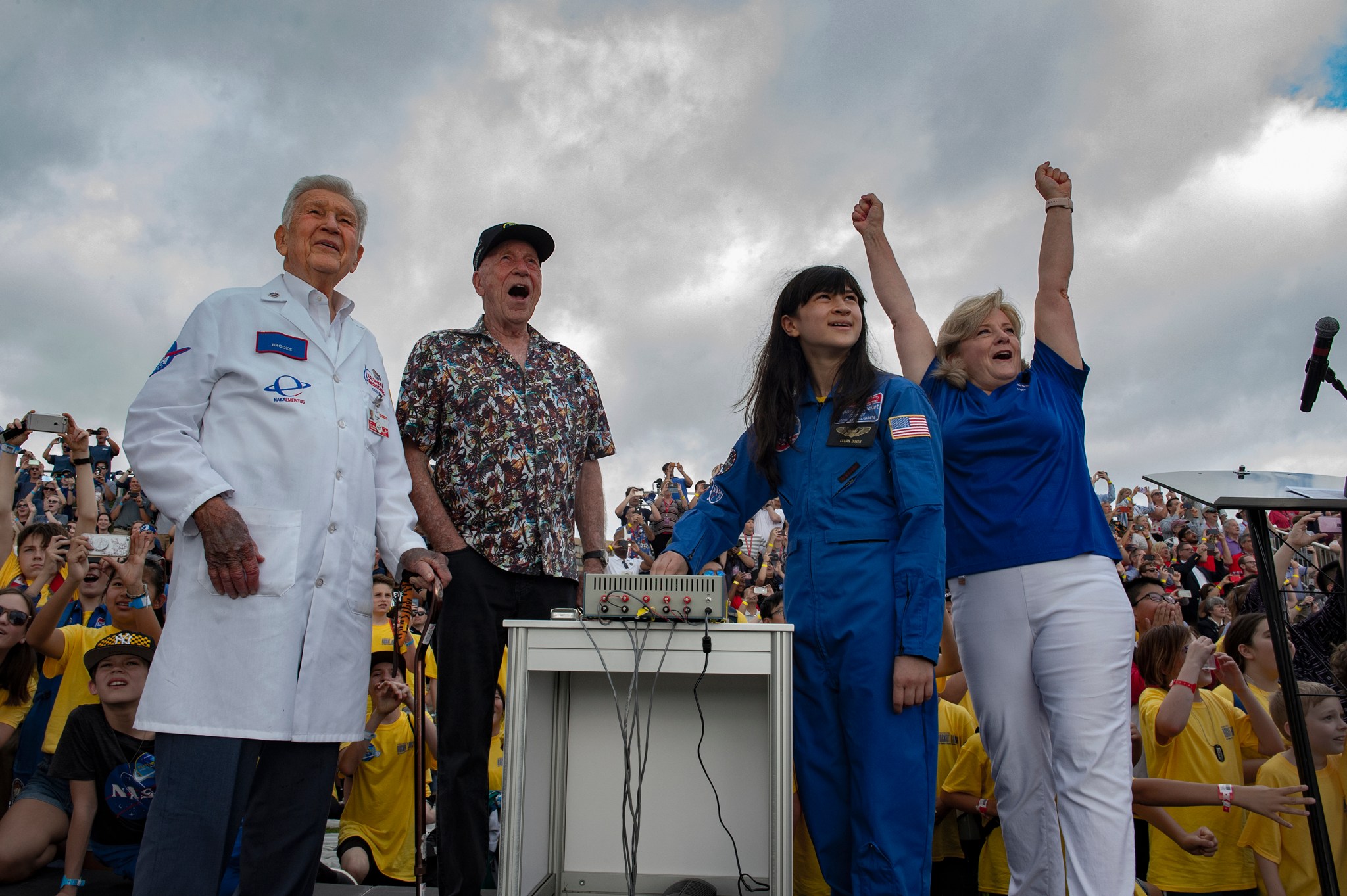
Jody Singer, far right, director of NASA’s Marshall Space Flight Center, celebrates as the model rockets launch. Also looking on, from left, are retired Marshall engineer Brooks Moore, Apollo 15 command module pilot Al Worden and Space Camp veteran Lillian Duran. Worden, who flew to the Moon in 1971, turned the key that primed the rockets, while Duran flipped the ignition switch. (NASA/Emmett Given)
Congrats to @RocketCenterUSA on their record-setting 5,000-rocket launch! #apollo50th pic.twitter.com/OyMTfdWIeb
— NASA Marshall (@NASA_Marshall) July 16, 2019
Science at the Moon: Still Much to Learn, say Marshall Researchers
By Rick Smith
NASA astronaut Edwin “Buzz” Aldrin’s vivid description of the lunar surface, uttered during the historic Apollo 11 mission in 1969, appears to have been half right. The Moon is indeed “magnificent,” but is it truly a place of “desolation?”
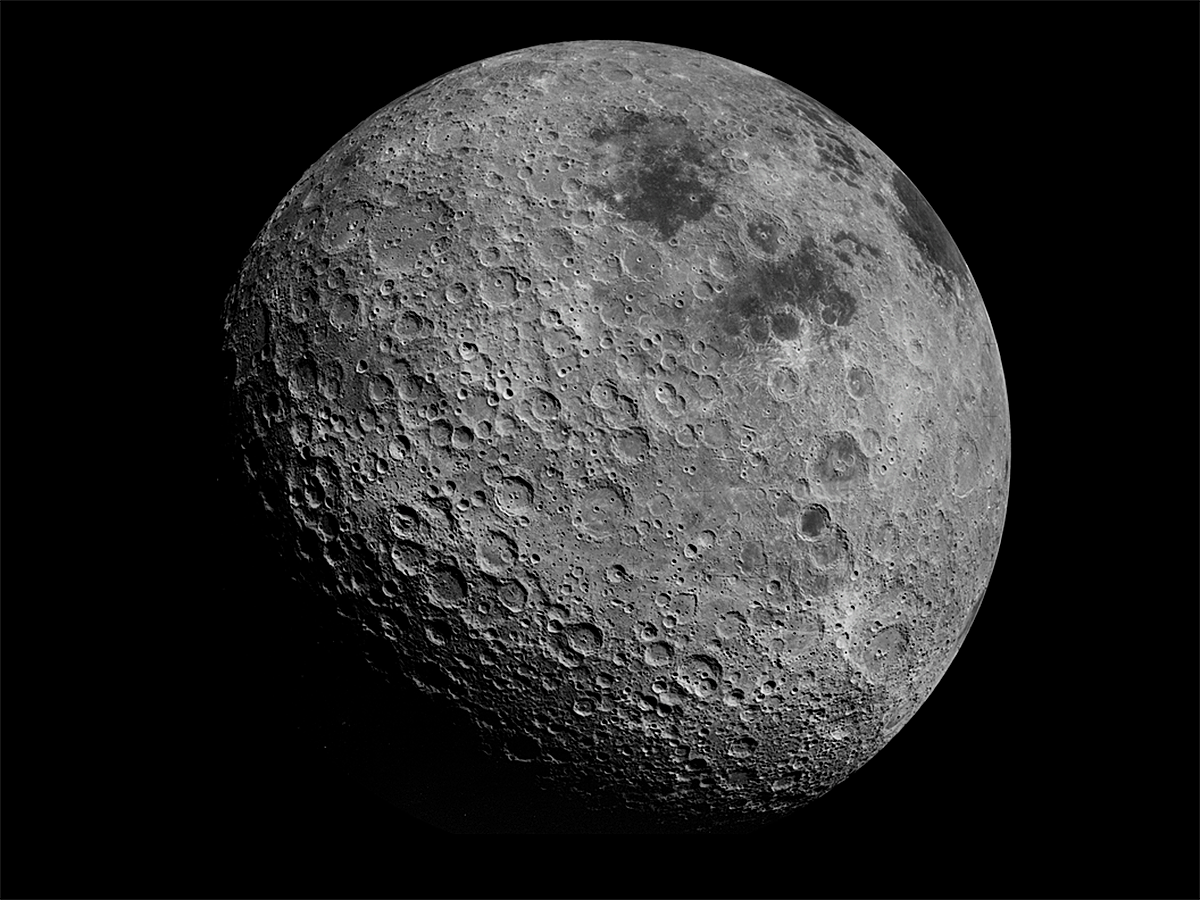
Researchers on three lunar science projects now underway at NASA’s Marshall Space Flight Center say we’ve barely scratched the surface — and there’s still so much to learn.
The Neutron Measurements at the Lunar Surface project, or NMLS, will use a neutron spectrometer to determine the amount of neutron radiation at the Moon’s surface. Such radiation occurs when solar protons and energetic particles from distant cosmic events slam into the Moon with up to a million times more energy than can be creating by the CERN Large Hadron Collider, the most powerful particle accelerator on Earth.
Given the health risks of prolonged radiation exposure, that’s a vital subject of study when it comes to long-term human forays on the Moon, especially given the fact that NASA’s Artemis program is working toward long-duration stays there beginning in 2028.
For Marshall’s Heidi Haviland, project scientist for NMLS, finding answers means building on previous data — including the Lunar Prospector’s findings in 1998-1999 and Fast Neutron Spectrometer tests on the International Space Station from 2016-2019 — to more precisely identify safe landing sites and ideal travel routes across the lunar surface.
But the science value goes further.
“Measuring neutrons may help detect the presence of hydrogen, water ice and other useful elements on the Moon,” she said, “and identify in situ resources critical for producing fuel and supplementing life support systems.”
The team led by principal investigator Peter Bertone, a Marshall physicist, and lead engineer Jeff Apple will deliver NMLS for scheduled launch in July 2021. Also underway, spearheaded by principal investigator and Marshall space scientist Mark Christl, is a second spectrometer bound for NASA’s lunar Gateway, the orbital platform that will oversee lunar activities and become a way station for future deep space missions.
As the NMLS team works to safeguard and aid explorers on the Moon, another Marshall team, led by Evan Anzalone, guidance and navigation lead in the Engineering Directorate, seeks to refine navigation and communications for those in lunar transit – above the Moon and traveling on its surface.
Anzalone is principal investigator for the Lunar Node 1 Navigation Demonstrator, a beacon to send orbiters and landing craft precise geolocation data, digitally confirming their position relative to other craft or ground stations. Currently, such navigation relies on NASA’s Deep Space Network, an international array of giant radio antennas which transmits positioning data to interplanetary spacecraft to keep them on course.
“We envision putting a similar hub on the Gateway and future landers, enabling lunar craft and crews to quickly, accurately confirm their position instead of relying on Earth,” Anzalone said. “It’s like getting verification from a lighthouse on the shore you’re approaching, rather than waiting on word from the home port you left days earlier.”
LN-1 will test a networked computer navigation system Anzalone developed and dubbed the Multi-spacecraft Autonomous Positioning System. It was successfully tested on the space station in 2018 using NASA’s Space Communications and Navigation testbed.

Eventually, Anzalone hopes to see beacons built into every craft and habitat on the Moon.
“Apollo astronauts kept sextants to determine their position,” he said. “Today, we’re building a sustainable infrastructure of communications assets to make our lunar explorers safer and more connected than ever before.”
Anzalone, project manager Anthony Guillory and their team are planning to have LN-1 ready to fly by March 2020.
Lunar Node 1 and NMLS both are sponsored by the Planetary Exploration Science Technology Office at NASA’s Glenn Research Center.
The Moon also offers a new vantage point for conducting science on an extragalactic scale — and Marshall astrophysicists Michelle Hui and Colleen Wilson-Hodge hope to use it to study the most colossal explosive forces in the cosmos. They’re the principal investigator and deputy principal investigator, respectively, on the proposed Moon Burst Energetics All-sky Monitor mission, or MoonBEAM.
Designed to be launched to an elliptical orbit some 62,000 miles to 372,000 miles out, MoonBEAM will help detect gamma-ray bursts tied to gravitational waves. Gamma-ray bursts, those ultra-powerful bursts of radiation from a collapsing star or the merger of a neutron star and a black hole, occur roughly once a day somewhere in our sky. But for detectors in Earth orbit, Hui pointed out, our planet can block 30% of that sky. Deploying MoonBEAM would slash that number to much less than 1%.
Furthermore, it increases pinpoint accuracy for cosmic burst hunters. “MoonBEAM’s orbit, on average, is 1.3 seconds from Earth orbit,” Hui said. “If MoonBEAM and an Earth-orbiting satellite both see the same gamma-ray burst, the time difference will permit us to triangulate its position more precisely. It’s like GPS for cosmic explosions.”
That difference could be huge, Wilson-Hodge agreed. It only takes a few degrees of error for researchers to find themselves hunting a needle in a cosmic haystack.
Marshall is partnering on MoonBEAM with the University of Alabama in Huntsville, the Universities Space Research Association and NASA’s Goddard Space Flight Center. Hui and Wilson-Hodge hope to see their work manifested on a lunar flight mission soon.
“The fact that we’re returning to the Moon enables a lot of science to ride along that we couldn’t do otherwise,” Wilson-Hodge said. “It’s all about investigating the cosmos and our place in it, how everything fits together. The best endeavors end up revealing things we never suspected, creating even more questions. That excites me most of all.”
Smith, an ASRC Federal/Analytical Services employees, supports the Office of Strategic Analysis & Communications.
What Would the First Woman on the Moon Say?
NASA’s Artemis program will put the first woman on the Moon in 2024. The Marshall Star asked female employees at NASA’s Marshall Space Flight Center what they would say if they took that historic first step.
Solving Combustion Instability Saved America’s First Trips to the Moon
By Will Bryan
In May 1961, the fledgling U.S. space program had just 15 minutes of manned spaceflight. Yet the decision on a monumental goal had already been made: Before 1970, NASA would land a man on the Moon and bring him home.
Bigger rockets with more powerful engines than the small Mercury-Redstone rocket, which launched the first two Americans into space, were needed. Bigger engines meant more complexity and unknown problems to the young engineers in charge of developing them.
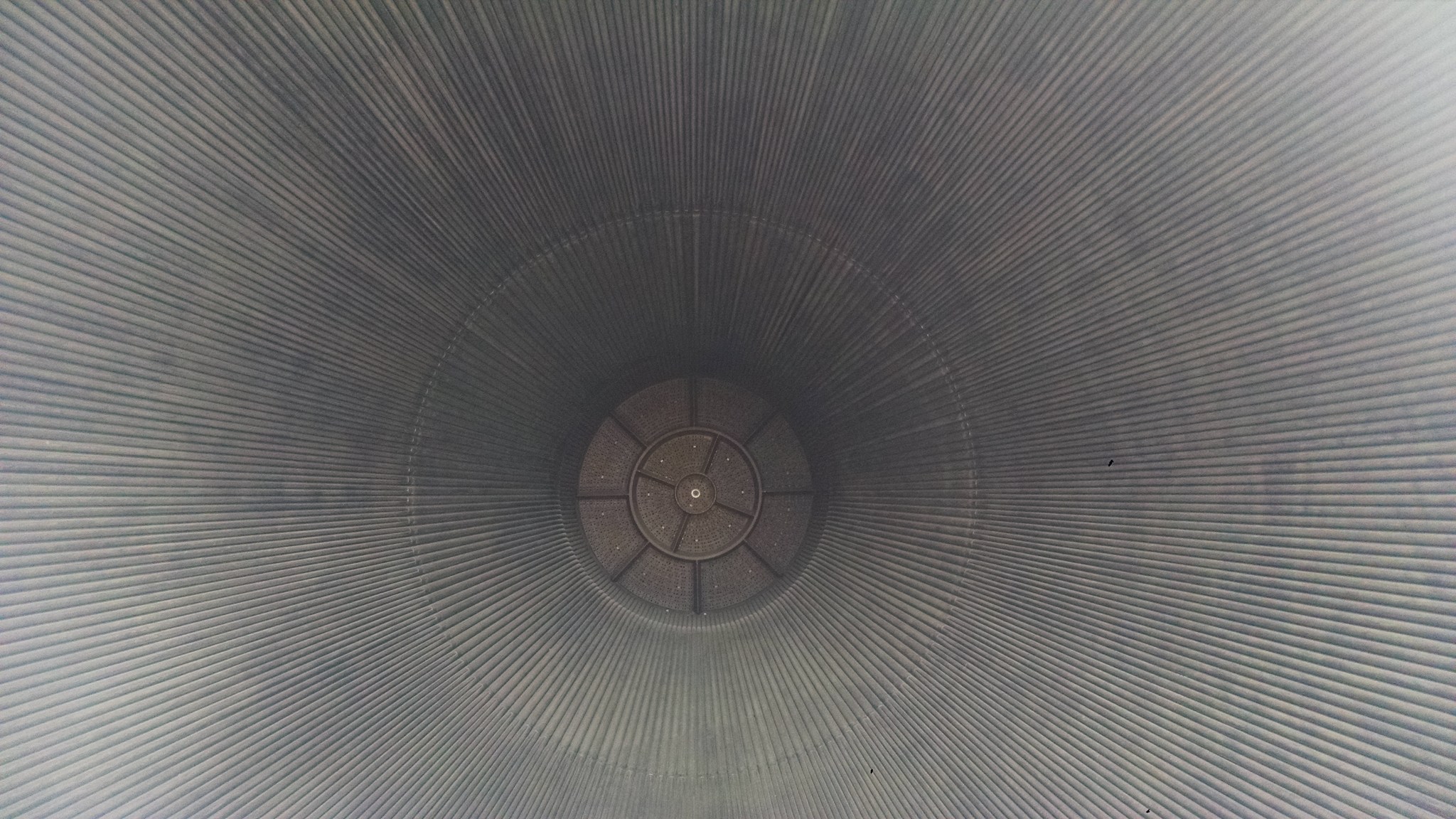
One of those engineers was 28-year-old Sonny Morea, and among the challenges was combustion instability — a problem that plagued the massive F-1 engine led by program manager Morea at NASA’s Marshall Space Flight Center.
“It was a disaster because once we had that instability, it would burn through the thrust chamber in milliseconds. The hardware went all over the place,” Morea said.
Five F-1 engines powered the Saturn V’s first stage and were tasked with launching the 36-story-tall, 6.5-million pound rocket.
In the simplest view, combustion instability can be thought of as pressure swings in the engine caused by the multiple streams of liquid oxygen and rocket fuel combining and igniting at extremely high pressures in such a way that causes violent vibrations. In the Saturn V’s first stage engine, those pressure swings could cause destruction in fractions of a second.
Morea helped form a team of combustion experts from across the country to solve the problem. After more than three years, they found an answer.

The solution resided in an earlier engine that did not experience the combustion instability issues the F-1 was having. The team determined that was due to the design of the injector plate through which the liquid oxygen and rocket fuel were fed into the combustion chamber. The injector plate on the engine was curved, fed by pods on the outside of the plate. Those pods acted as small rocket engines outside the thrust chamber, which resulted in the initial combustion taking place in smaller pockets in the large combustion chamber.
For Morea’s team, though, it was too late in development to change the shape of the flat F-1 injector plate. Instead, they added copper dividers, called baffles, between injector holes to create compartments on the plate which they hoped would stabilize the engine. After multiple test firings, the solution appeared to work.
The next challenge was determining how the engine would react if there was instability. The team took a literally explosive approach — they placed a small bomb in the center of the F-1 and ignited it at the same time they ignited the engine. The idea was to drive the engine unstable to determine if the baffles would stabilize the engine.
“And lo and behold, that’s what happened. The baffles seemed to solve the problem,” Morea said.
Multiple tests and multiple “bombings” during the tests gave the team a high level of confidence that the baffles would dampen out the vibrations should they arise. They had done all they could do, and that gave the astronauts great confidence as well.
From 1967 to 1973, 65 F-1 engines propelled 13 Saturn V rockets off the launch pad and on the way into space without any combustion instability problems.
As NASA and the country celebrate the 50th anniversary of the Apollo program, the stories, lessons and ingenuity of the Saturn and Apollo teams are again powering America’s way to the Moon. NASA will return to the Moon by 2024, landing the first woman and the next man on the Moon’s south pole. With Artemis, NASA will also establish a sustainable human presence on the Moon by 2028 to uncover new scientific discoveries, demonstrate new technological advancements and lay the foundation for private companies to build a lunar economy.
Visit here to learn more about NASA’s first voyages to the Moon. Visit here to learn more about NASA’s return to the Moon and Artemis.
Bryan, an ASRC Federal/Analytical Services employee, supports the Office of Strategic Analysis & Communications.
Shooting the Moon: Local Photographer’s Image Selected for Apollo Postage Stamp Collection
By Janet Sudnik
Gregory H. Revera has been an amateur photographer and space enthusiast from as early as he can remember. Originally from New Jersey, Revera inherited his love of photography from his father and grandfather, both engineers. Capturing mostly landscapes and vacation snaps, he learned to shoot and develop film.
Alongside this growing hobby, watching Carl Sagan’s “Cosmos” television series and other space-themed documentaries piqued his interest in astronomy and the space program from a young age.
“I once got in trouble for correcting my elementary school teacher on how many moons Jupiter had,” Revera said. “The textbooks said 12 or 13, but Voyager had just discovered additional moons.”
Though from the East Coast, Revera met his wife in school at the University of Miami, and they relocated to Alabama to be closer to her hometown of Hartselle. He lives and practices law in Madison, and it was from his North Alabama back yard that he took an iconic lunar photo.
Around 2009, he started seeing high quality amateur photos of the Moon, planets and deep space appearing online, some that rivaled the best film images produced by professional observatories. He paired his 9.25-inch Schmidt Cassegrain telescope with his wife’s Canon EOS Rebel camera and began photographing the sky. On Oct. 10, 2010, he captured the perfectly full Moon.
“I think the depth seen in these craters is what gives the image an allure over other full Moon photographs,” he said. “The image is actually a combination of about 20 digital photographs that are ‘stacked’ together. This process helps minimize the distortion that occurs from turbulence in the atmosphere.”
He originally posted the image online in hopes of being chosen as Wikipedia’s Picture of the Day. It was not selected then, but it became and remains the main image on the web encyclopedia’s Moon page, and has since been used by countless media outlets, and by NASA.
In 2017, the U.S. Postal Service reached out to Revera, having seen the image online. They told him his Moon photo was being considered for a commemorative stamp collection to mark the 50th anniversary of Apollo 11. He wouldn’t learn that it had been chosen until a public announcement in March 2019.
The “forever” stamp collection features two designs: one of Neil Armstrong’s iconic photo of a spacesuited Edwin “Buzz” Aldrin on the lunar surface; the other of Revera’s full Moon with the landing site of the lunar module Eagle in the Sea of Tranquility indicated with a yellow dot. Postal Service art director Antonio Alcalá designed the stamp art. The stamps will be available to the public beginning July 19.
“I am a space enthusiast, but in my daily life have nothing to do with the space program,” Revera said, “so I am extremely honored and humbled to have a photograph I took from my back yard in Madison used by the Postal Service to celebrate the 50th anniversary of mankind’s greatest technological achievement.”
Visit the Apollo 50th website for an in-depth look at the program, including historic footage, audio tapes, photography, posters, resources and information on anniversary events across the country.
You can view more of Revera’s space images on Instagram and at www.revera.space.
Sudnik is a public affairs officer in the Office of Strategic Analysis & Communications.
Space Blanket, Dampers Among Apollo Program’s Legacy of Spinoffs
By Will Bryan
There’s more space in your life than you think. While NASA celebrates the 50th anniversary of the Apollo 11 Moon landing, many of the technologies developed to put the first humans on the Moon are used by people all around the world every day. NASA’s Marshall Space Flight Center has a hand in many of those commercial technologies and products, called spinoffs.
Undoubtedly, the “space blanket” is one of the most recognizable of all of NASA spinoffs. Comprised of metal vaporized onto plastic, it reflects heat back to its source and is very lightweight. Apollo missions took advantage of the NASA-developed material — called metallized polyethylene terephthalate — to protect spacecraft systems and astronauts from the extreme temperatures of space. In the five decades since its creation, MPET has been used in a multitude products — saving lives and bolstering recreation.
Examples of recreational uses abound. After running 26.2 miles and crossing the finish line, marathon runners are draped with a sheet of MPET to prevent hypothermia. The body continues sweating even after running has stopped, making runners in wet clothes even wetter. The space blanket material keeps runners warm until they can get into their dry clothes, which can take nearly half an hour at some of the largest races. David Deigan — a former employee of a now-shuttered company that supplied the heat-reflecting material to NASA — founded AFM Inc. of Chicago and branded the material HeatSheets. AFM now supplies products using the material to races all around the world and has also worked with partner companies to make products that can be used in emergency and disaster-stricken areas.
While saving lives is vital, MPET can also protect electronic devices. Former Boy Scout Nick Blanton and his company Salt Cases in Portland, Maine, created cases for smartphones and tablets using the material as one of the layers. The cases can protect electronic devices whether they are in a hot car or on frosty ski slopes.
The founders of JUNTO LLC in Philadelphia found that the space blanket could be a useful for protecting something else: beverages. Their product, called the KegSheet, is a cover for kegs which keeps them colder for longer simply by reflecting heat away, thus preventing consumers from having to refill coolers with ice. The KegSheet was created while the founders were preparing to watch an annual bicycle race in Philadelphia. Dan Gwiazdowski, now Junto’s creative director, remembered the space blanket in his car and wrapped it around a keg. It worked, and a product and company soon followed.
Engineers at Marshall also helped advance a technology to protect the Saturn V rocket from being struck by umbilical arms as they quickly retracted from the launching rocket. Special shock absorbers — called dampers — developed by Taylor Devices of North Tonawanda, New York, and brought to NASA enabled the arms to rapidly retreat from the rocket and not bounce back into it. The technology was further developed with NASA for use with the space shuttle launch towers.
Taylor Devices used the experience and knowledge gained from working with NASA, along with the technologies, to develop dampers for buildings in earthquake-prone environments. The shock absorbers are installed in more than 600 buildings and structures worldwide and their use has saved property, money and lives during earthquakes.
Teams at NASA are dedicated to making technology developed for the exploration of space and the advancement of aeronautics available to the public. The technologies create new industries and provide jobs. Just one technology can spinoff a multitude of products and companies as MPET did. The innovative spinoffs save lives and carry on the legacy of Apollo — a legacy that will continue to grow as NASA and humanity explore deeper into the solar system and universe than ever before.
Visit NASA’s Benefits to You page to learn more.
Bryan, an ASRC Federal/Analytical Services employee, supports the Office of Strategic Analysis & Communications.
Rocket Science in 60 Seconds: How Many Centers Work on the NASA Artemis Program?
Rocket Science in 60 Seconds gives you an inside look at work being done at NASA to explore deep space. Dawn Stanley is the deputy director for cross program system integrations for the Space Launch System rocket at NASA’s Marshall Space Flight Center. In this episode, she explains how each of the NASA centers works together on the agency’s Artemis program to help send American astronauts to the Moon — and on to Mars. For more information about SLS, visit https://www.nasa.gov/sls.
NASA SLS Rocket Testing Ensures Astronaut Safety, Mission Success
As the world reflects on the 50th anniversary of the Apollo missions, NASA is looking forward to its next giant leaps. One way NASA ensures the safety of astronauts and the success of the Artemis missions to the Moon in preparation for future missions to Mars is by testing the Space Launch System rocket structures.
With the recent delivery of the last structural test article, the liquid oxygen tank, to NASA’s Marshall Space Flight Center, and the start of testing in June for the largest structural test article — the 149-foot-tall liquid hydrogen tank — NASA is more than halfway through SLS structural testing.
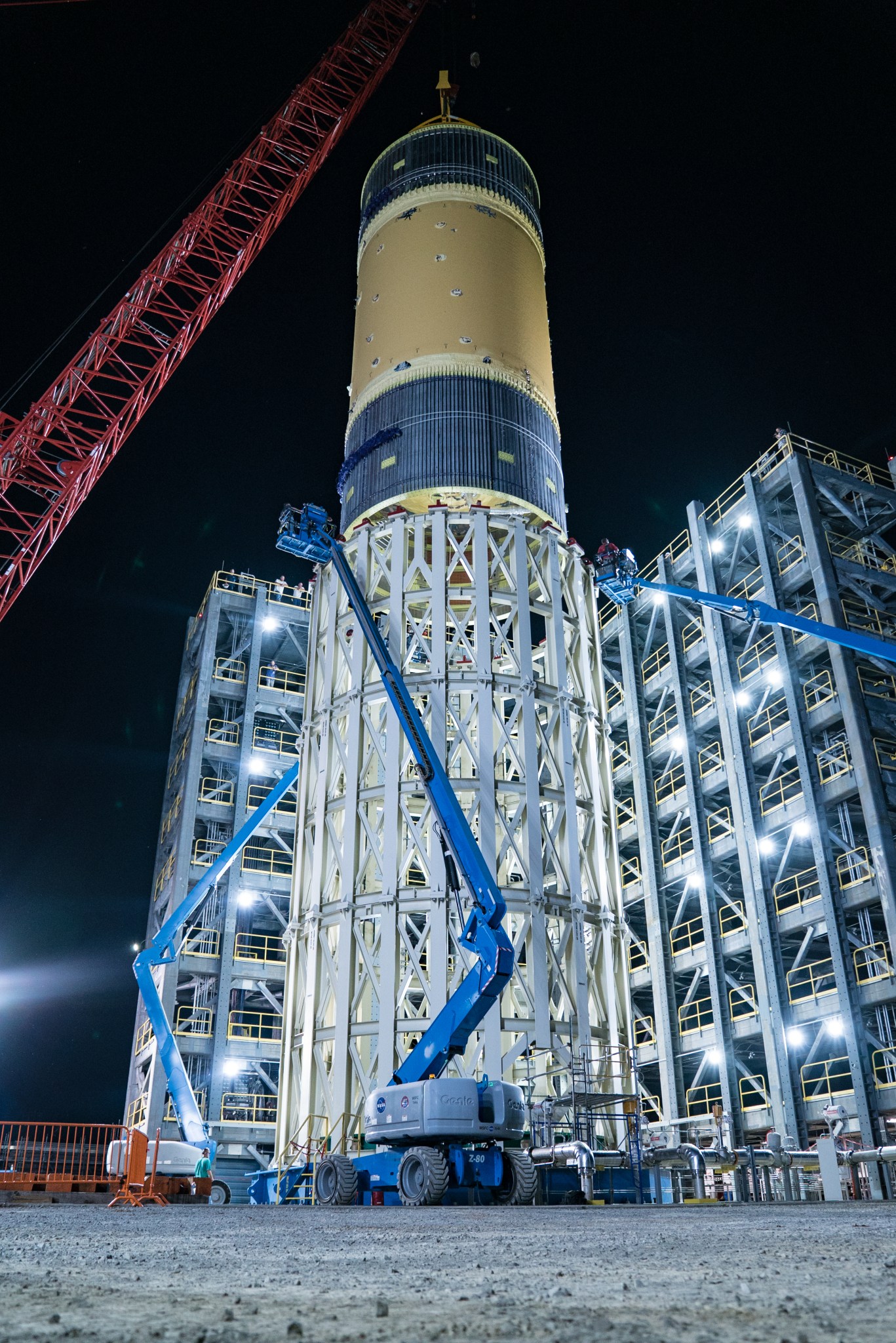
“This is a historic moment for the Marshall team as well as a significant milestone for the Artemis program,” SLS program manager John Honeycutt said. “We are more than halfway through the largest test campaign at Marshall since articles from NASA’s Space Shuttle Program were tested here. With the delivery of the liquid oxygen tank test article, we’re entering the final stage of Space Launch System structural testing.”
SLS, the agency’s first rocket built to send humans to deep space since the Saturn V, will have the power to take astronauts forward to the Moon and ultimately to Mars. Testing the new, increasingly complex pieces of hardware for the first flight of SLS and NASA’s Orion spacecraft is critical to the success not only of the first mission but to future missions, especially for the core stage that is used on all configurations of the rocket.
Marshall has tested major components of the core stage, upper stage and payload structures for SLS to determine they will be able to withstand the forces and conditions they will ultimately face during launch and flight. To date, Marshall test engineers have completed testing on the entire upper part of the rocket, which includes the interim cryogenic propulsion stage that will give Orion the final boost to the Moon, and two of the four core stage pieces being tested: the engine section that connects to the four RS-25 engines and the intertank, the piece of the core stage that feels the most force during launch and solid rocket booster separation.
“Here at Marshall we’re able to see firsthand how unique each of the different core stage components are from one another,” said Matthew Cash, lead structural test engineer for the intertank and liquid oxygen tank structural testing. “More than 11 million pounds of force was applied to the intertank. That’s the most of any SLS test element.”
The Marshall team completed testing on the intertank in June, which included tests to see just how much force the intertank could stand, and then began testing the liquid hydrogen tank test article. During testing, dozens of hydraulic cylinders at Marshall’s Test Stand 4693 push and pull on the giant tank to mimic the same stresses and forces it will endure during liftoff and flight.
Engineers are preparing the last structural test article, the liquid oxygen tank, to begin testing this fall. All test articles, including the liquid hydrogen and the liquid oxygen tanks, are structurally identical to their flight versions. The liquid hydrogen tank test article is bolted to a huge 80,000-pound steel ring on the test stand, where it is suspended within the test stand with the loads applied at the base. Thirty-eight hydraulic cylinders are then calibrated and positioned all along the tank to apply millions of pounds of crippling force from all sides, and engineers measure and record the effects of the launch and flight forces. Meanwhile, the test article is filled with cryogenic fluid to simulate fuel and propellants used during flight.
“It will take about four months to complete each of the test scenarios,” said Mike Nichols, the test conductor for the liquid hydrogen tank tests “Engineers carefully monitor the testing and data from stations several miles away, noting how the tank responds to the varying pressures and mechanical loading through a series of sensors attached to the tank.”
The rocket’s massive core stage is made up of five major components: the engine section, liquid hydrogen tank, intertank, liquid oxygen tank and the forward skirt. Together, these five parts make up the “core” of the rocket, and all the qualification testing will verify the components of the core stage are ready for Artemis 1.
The Space Launch System is the most powerful rocket ever built by NASA. It’s designed to safely send humans to the Moon — to stay — so that a new era of deep space exploration is possible. Testing ensures the success, not only of the initial flights, but also those SLS flights that will carry American astronauts to the Moon and ultimately to Mars.
Marshall Remembers Apollo
This Marshall Remembers Apollo video series conducted as part of the Apollo 11 50th anniversary celebration consists of edited oral history interviews with former and current NASA employees related to their experience working at Marshall Space Flight Center during the years of the Saturn Program.
Margrit von Braun, daughter of former Marshall center director Wernher von Braun, discusses growing up in Huntsville as well as life with her famous father.
Other Marshall Remembers Apollo videos: Carolyn Griner, Armis Len Worlund, J. Wayne Littles, Jay Foster, Nancy Guire, Rein Ise, Phil Sumrall, William W. Vaughan, Ann Whitaker, Ed Buckbee, Earnest C Smith, Otha “Skeet” Vaughan, Jan Monk, Spike Field, Bill Sneed, James Jennings and Billie Robertson.
Marshall Retirees Association Plans Memorial to Honor Space Explorers
The NASA Marshall Space Flight Center Retirees Association and the U.S. Space & Rocket Center are cooperating on a project to honor past and present Marshall employees, and commemorate the 50th anniversary of the first Moon landing.
The retirees association is working with Marshall to create a database containing the name of every federal employee who has worked at Marshall. The database – which currently contains more than 15,000 names — will be available to the public in kiosks at the Space & Rocket Center in time for the Moon landing celebrations and is currently accessible at https://www.marshallretirees.org/space-explorers/ and https://www.marshallretirees.org/. In addition, the retiree association is interacting with the contractor community to determine how best to include contract employees in the database.
There are also plans to create a memorial at the Space & Rocket Center to honor those listed in the database, their accomplishments and representations of some of Marshall’s best-known rockets and spacecraft. A design committee is exploring options for the structure and is considering a dynamic fountain and a state-of-the-art light show. Employees and their family members can submit contact information and be informed about the memorial’s progress.
“This memorial will be a fitting tribute to the men and women who have made such a major contribution to America’s space program,” said Parker Counts, president of the retirees association. “They have played a key role in landing Americans on the Moon and in so many other major NASA accomplishments, such as Skylab, the space shuttle, Spacelab, Hubble Space Telescope, Chandra X-ray Observatory and the International Space Station.”
Car Show Brings Memories, Nostalgia of Early Rocketry Days
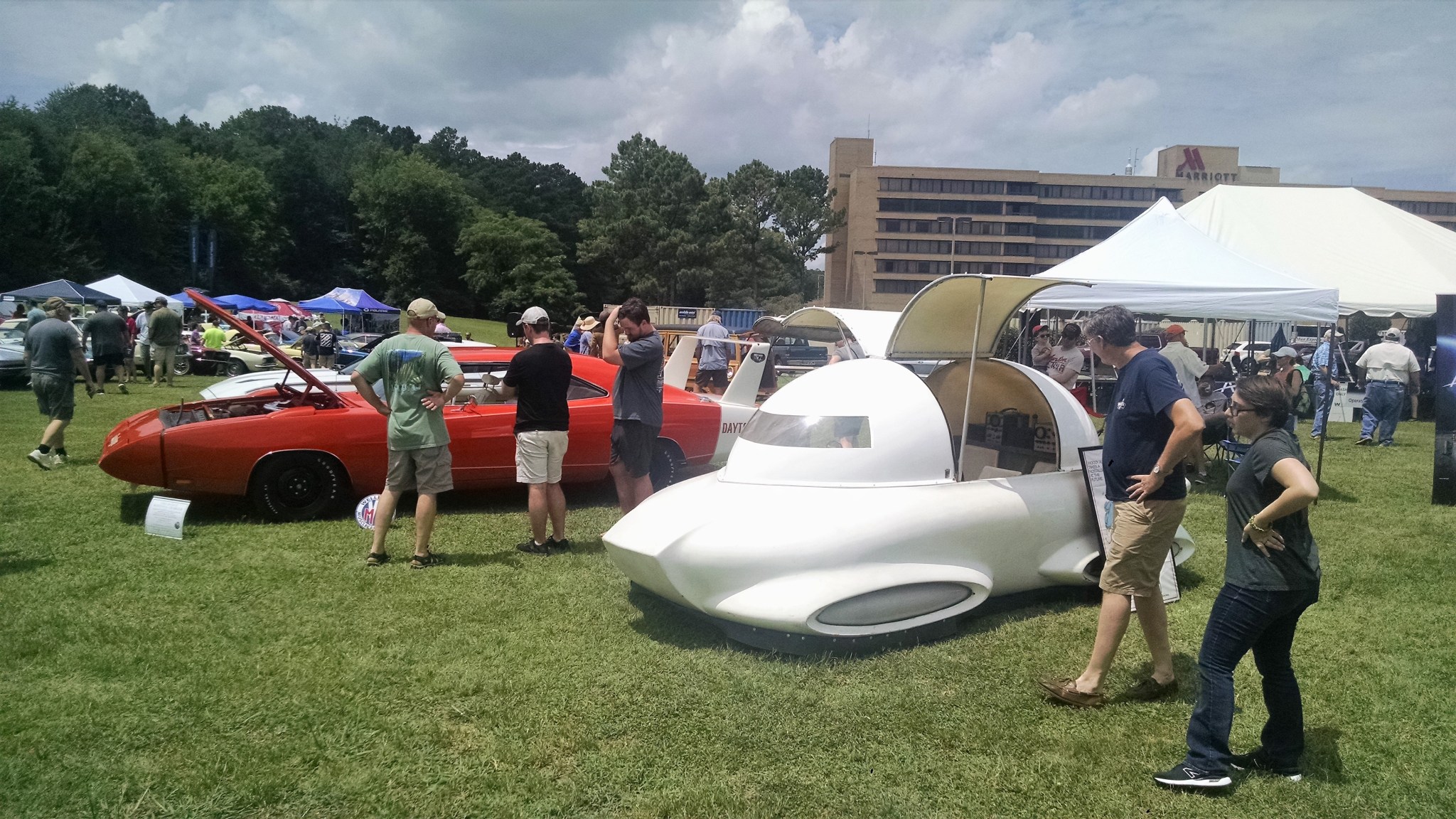
Nearly 100 cars and trucks from 1945-1975 were part of the Apollo 50th Celebration Car Show on July 13 at the Huntsville Marriott next to the U.S. Space & Rocket Center. The vehicles spanned the earliest decades of space exploration, both in the United States and Europe, and each has a connection to the space program. (NASA/Will Bryan)
This Week in NASA History: Apollo 11 Launches – July 16, 1969
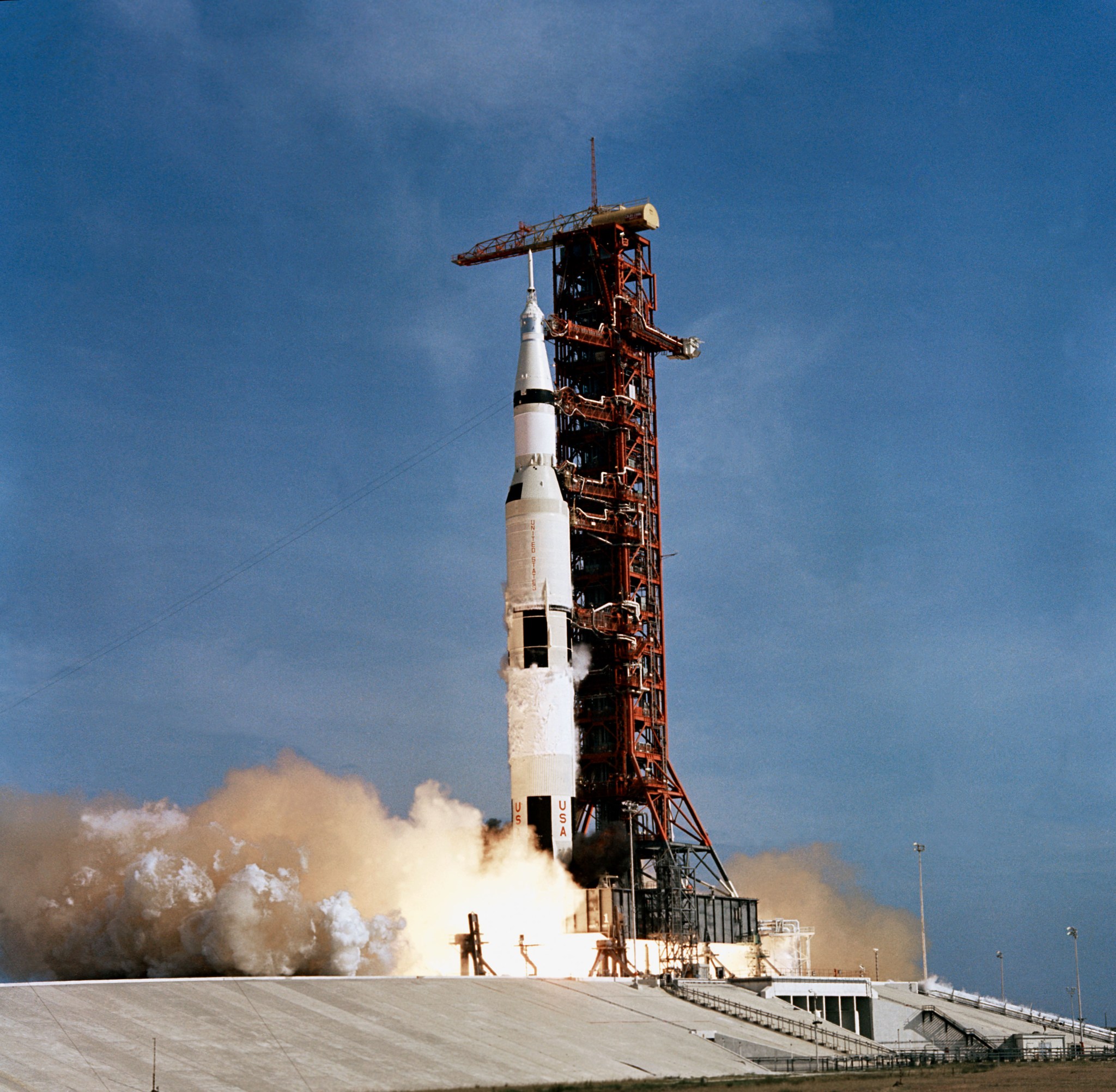
This week in 1969, Apollo 11 launched from NASA’s Kennedy Space Center carrying astronauts Neil Armstrong, Edwin “Buzz” Aldrin and Michael Collins. The primary mission objective was to fulfill a national goal set by President John F. Kennedy on May 25, 1961, to perform a crewed lunar landing and return safely to Earth before the decade was out. On July 20, Armstrong and Aldrin became the first men to walk on the Moon. The two astronauts spent more than 21 hours on the lunar surface deploying scientific experiments and gathering samples before returning to the orbiting command module, piloted by Collins. This July, in a series of special events, NASA is marking the 50th anniversary of the Apollo Program — the historic effort that sent the first U.S. astronauts into orbit around the Moon in 1968, and landed a dozen astronauts on the lunar surface between 1969 and 1972. For more pictures, and to connect to NASA’s remarkable history, visit the Marshall History Program’s webpage. (NASA)


























